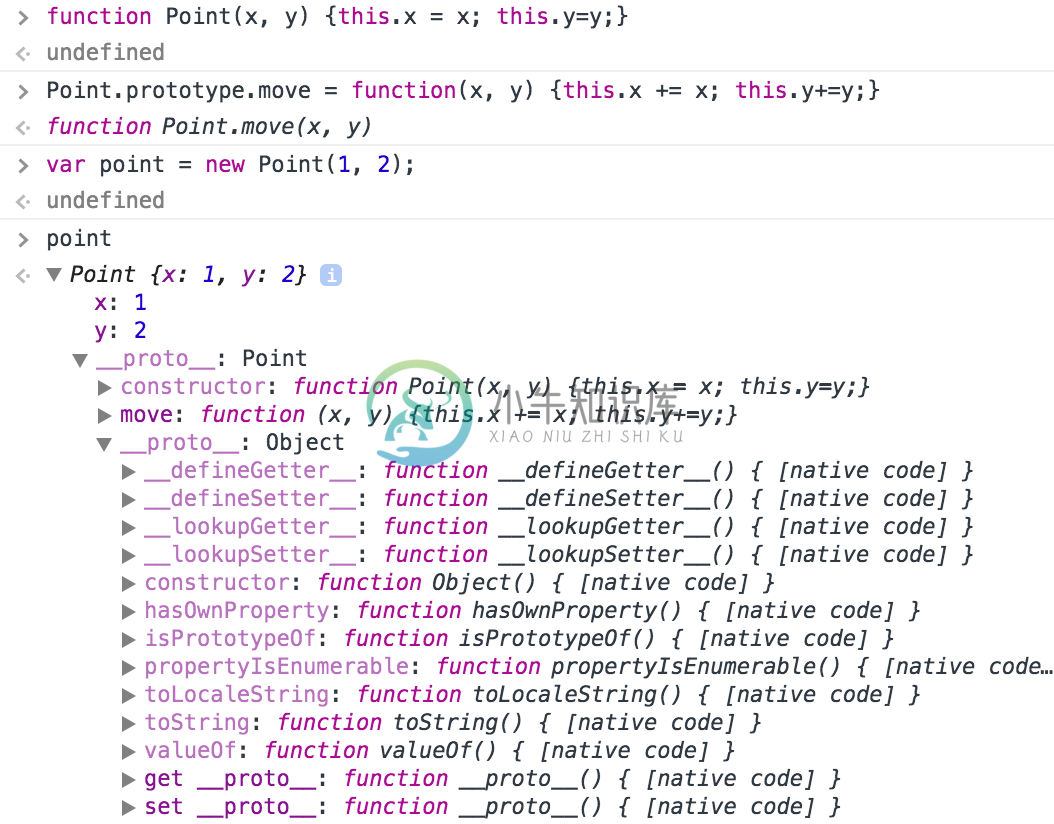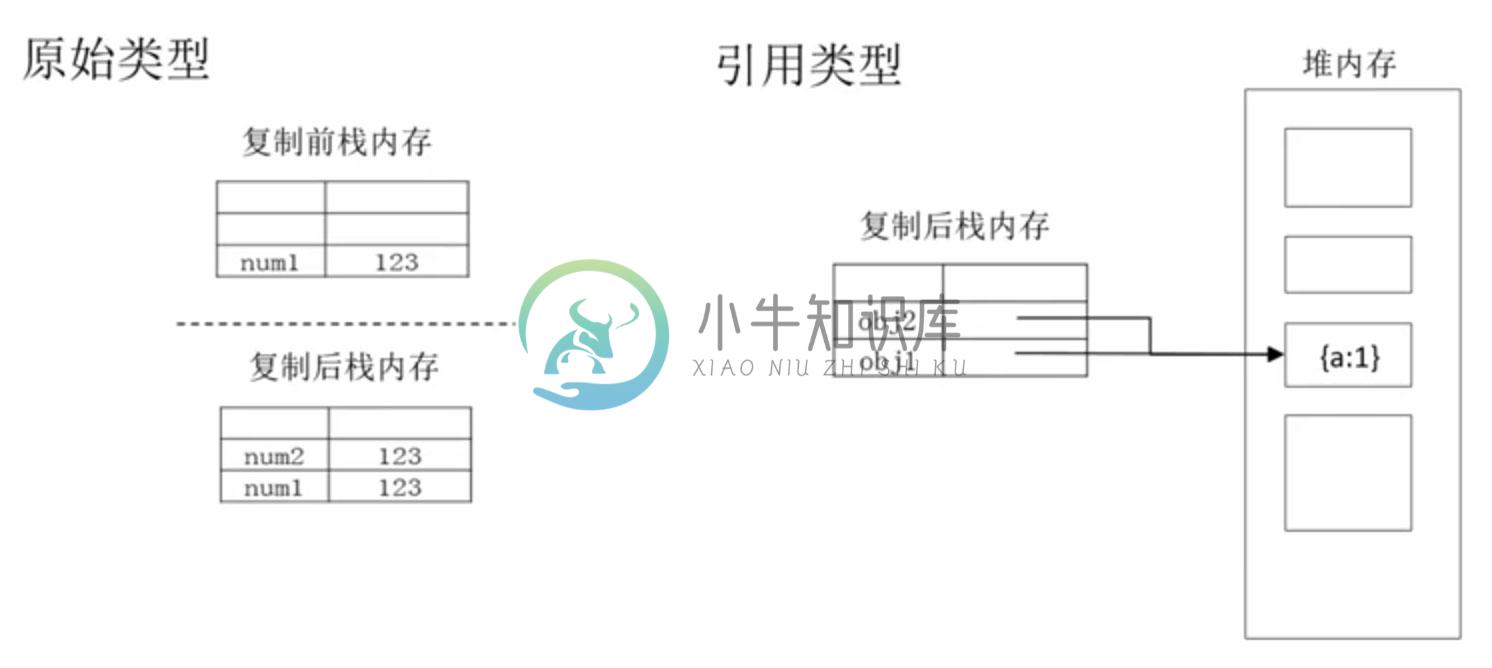内置对象
内置对象
通常情况下只有对象才存在方法,但 JavaScript 不同它具有12种内置对象。内置对象又分为两类,普通对象(属性和方法)与构造器对象(可用于实例化普通对象,它还包含原型对象属性和方法,及实例对象属性和方法)。
JavaScript 对象原型链的简要说明
function Point(x, y) {
this.x = x;
this.y = y;
}
Point.prototype.move = function(x, y) {
this.x += x;
this.y += y;
}
var p = new Point(1, 1);
p.move(2,2);
__proto__ 称之为原型链,有如下特点:
__proto__为对象内部的隐藏属性__proto__为实例化该对象的构造器的prototype对象的引用,因此可以直接方法prototype的所有属性和方法- 除了
Object每个对象都有一个__proto__属性且逐级增长形成一个链,原型链顶端是一个Object对象。 - 在调用属性或方法时,引擎会查找自身的属性如果没有则会继续沿着原型链逐级向上查找,直到找到该方法并调用。
__proto__跟浏览器引擎实现相关,不同的引擎中名字和实现不尽相同(chrome、firefox中名称是__proto__,并且可以被访问到,IE中无法访问)。基于代码兼容性、可读性等方面的考虑,不建议开发者显式访问__proto__属性或通过__proto__更改原型链上的属性和方法,可以通过更改构造器prototype对象来更改对象的__proto__属性。
构造器对象与普通对象的区别
- 构造器对象原型链中的
__proto__是一个Function.prototype对象的引用,因此可以调用Function.prototype的属性及方法 - 构造器对象本身有一个
prototype属性,用该构造器实例化对象时该prototype会被实例对象的__proto__所引用 - 构造器对象本身是一个
function对象,因此也会有自身属性
标准内置对象
构造器对象
- Object
- Boolean
- String
- Number
- Function
- Array
- RegExp
- Date
- Error
其他对象
- Math
- JSON
- 全局对象
内置对象,其实也叫内置构造器,它们可以通过 new 的方式创建一个新的实例对象。内置对象所属的类型就叫内置对象类型。其声明方式如下:
var i = new String("str"); // String Object
var h = new Number(1); // Number Object
var g = new Boolean(true); // Boolean Object
var j = new Object({name : "Tom"}); // Object Object
var k = new Array([1, 2, 3, 4]); // Array Object
var l = new Date(); // Date Object
var m = new Error();
var n = new Function();
var o = new RegExp("\\d");
注意:虽然标准类型中有Boolean String Number Object,内置对象类型中也有Boolean String Number Object,但它们其实是通过不同的声明方式来进行区别的。标准类型通过直接赋值,而对象类型则是通过构造器实现初始化。
Object
构造器的原型对象在对象实例化时将会被添加到实例对象的原型链当中。
__proto__为原型链属性,编码时不可被显像调用。但是实例化对象可以调用原型链上的方法。
用 String/Number 等构造器创建的对象原型链顶端对象始终是一个Object对象,因此这些对象可以调用Object的原型对象属性和方法。所以 String/Number 等构造器是 Object 的子类。
更多关于 Object 的内容可以在这里找到。
构造器说明:
- Object 是属性和方法的集合
- String/Number/Boolean/Array/Date/Error 构造器均为 Object 的子类并集成 Object 原型对象的属性及方法。
实例化方法
var obj0 = new Object({name: 'X', age: 13});
// 常用方法
var obj1 = {name: 'Q', age: 14};
属性及方法
- prototype
- create
- keys
- ...
**原型对象属性及其方法
- constructor
- toString
- valueOf
- hasOwnProperty
- ...
实例对象属性及方法
无
Object.create
功能:基于原型对象创造新对象
// Object.create(prototype[, propertiesObject])
var prototype = {name: 'X', age: 13};
var obj = Object.create(proto);
Object.prototype.toString
功能:获取方法调用者的标准类型
// objectInstance.toString()
var obj = {};
obj.toString(); // Object
Object.prototype.hasOwnProperty
功能:判断一个属性是否是一个对象的自身属性
// objectInstance.hasOwnProperty("propertyName")
var obj = Object.create({a: 1, b: 2});
obj.c = 3;
obj.hasOwnProperty('a'); // false
obj.hasOwnProperty('c'); // true
Boolean
构造器说明:值为 true 与 false
属性及方法
- prototype
**原型对象属性及其方法
- constructor, toString, valueOf
String
构造器说明:单双引号内的字符串
实例化方法
'Hello, world!'
var str0 = 'Xinyang';
var str1 = new String('Xinyang');
属性及方法
- prototype
- fromCharCode(转换 ASCII 代码为字符)
原型对象属性及其方法
- constructor
- indexOf
- replace
- slice
- split
- charCodeAt
- toLowerCase
- ...
String.prototype.indexOf
功能:获取子字符串在字符串中的索引
// stringObject.indexOf(searchValue, fromIndex)
var str = "I am X. From China!";
var index = str.indexOf('a'); // 2
str.indexOf('a', index + 1); // 16
str.indexOf('Stupid'); // -1 字符串不存在
String.prototype.replace
功能:查找字符串替换成目标文字
// stringObject.replace(regexp/substr, replacement)
var str = "apple is bad";
str = str.replace('bad', 'awesome');
String.prototype.split
功能:按分隔符将分隔符分成字符串数组
// stringObject.split(separator, arrayLength)
var str = '1 2 3 4';
str.split(' '); // ['1', '2', '3', '4'];
str.split(' ', 3); // ['1', '2', '3'];
str.split(/\d+/); // ["", " ", " ", " ", ""]
Number
构造器说明:整型直接量,八进制直接量(0-),十六进制直接量(0x-),浮点型直接量
实例化方法
10
1.2e5
var count = 0x10;
var pi = new Number(3.1415);
属性及方法
- prototype
- MAX_VALUE
- MIN_VALUE
- NaN
- NEGATIVE_INFINITY
- POSITIVE_INFINITY
原型对象属性及其方法
- constructor
- toFixed
- toExponential
- ...
Number.prototype.toFixed
功能:四舍五入至指定小数位
// numberObject.toFixed(num)
var num0 = 3.14;
num0.toFixed(1); // 3.1
var num1 = 3.35;
num1.toFixed(1); // 3.4
Array
构造器说明:定义数组对象
实例化方法
var a0 = [1, 'abc', true, function(){}];
var a1 = new Array();
var a2 = new Array(1, 'abc', true);
属性及方法
- prototype
- isArray
原型对象属性及其方法
- constructor
- splice
- forEach
- find
- concat
- pop
- push
- reverse
- shift
- slice
- ...
Array.prototype.splice
功能:从数组中删除或添加元素,返回被删除的元素列表(作用域原有数组)
// arrayObject.splice(start, deleteCount[, item1[, item2[, ...]]])
var arr = ['1', '2', 'a', 'b', '6'];
var ret = arr.splice(2, 2, '3', '4', '5'); // ['a', 'b']
arr; // ['1', '2', '3', '4', 5', '6']
Array.prototype.forEach
功能:遍历元素组并调用回调函数
// arrayObject.forEach(callback[, thisArg])
// 回调函数
// function callback(value, index, arrayObject) {...}
// value - 当前值 index - 当前索引 arrayObject - 数组本身
function logArray(value, index, arrayObject) {
console.log(value);
console.log(value === array[index]);
}
[2, 5, 6, 9].forEach(logArray);
Function
构造器说明:定义函数或新增对象构造器
实例化方法
// 对象实例化
var f0 = new Function('i', 'j', 'return (i + j)');
// 函数关键字语句
function f1(i, j){return i + j;}
// 函数表达式
var f3 = function(i, j){return i + j;};
属性及方法
- prototype
原型对象属性及其方法
- constructor
- apply
- call
- bind
实例对象属性和方法
- length
- prototype
- arguments
- caller
自定义对象构造器
下面的代码声明一个 Point 增加了一个move方法,最后创建了一个 Point 的实例对象。
function Point(x, y) {
this.x = x;
this.y = y;
}
Point.prototype.move = function(x, y) {
this.x += x;
this.y += y;
}
var p = new Point(1, 2);
Function.prototype.apply
功能:通过参数指定调用者和函数参数并执行该函数
// functionObj.apply(thisArg[, argsArray])
function Point(x, y) {
this.x = x;
this.y = y;
}
Point.prototype.move = function(x, y) {
this.x += x;
this.y += y;
}
var p = new Point(1, 1);
var circle = {x: 1, y: 1, r: 1};
p.move.apply(circle, [2, 1]); // {x: 3, y: 2, r: 1}
Function.prototype.bind
功能:通过参数指定函数调用者和函数参数并返回该函数的引用
// functionObj.bind(thisArg[, arg1[, arg2[, ...]]])
function Point(x, y) {
this.x = x;
this.y = y;
}
Point.prototype.move = function(x, y) {
this.x += x;
this.y += y;
}
var p = new Point(1, 1);
var circle = {x: 1, y: 1, r: 1};
var circleMoveRef = p.move.bind(circle, 2, 1);
setTimeout(circleMoveRef, 1000); // {x: 3, y: 2, r: 1}
// 之间使用 circleMoveRef() 效果等同于 apply()
circleMoveRef();
子类构造器
function Circle(x, y, r) {
Point.apply(this, [x, y]);
this.radius = r;
}
Circle.prototype = Object.create(Point.prototype);
Circle.prototype.constructor = Circle;
Circle.prototype.area = function(){
return Math.PI * this.radius * this.radius;
}
var c = new Circle(1, 2, 3);
c.move(2, 2);
c.area();
函数调用
()applycall
函数参数
- 形参个数不一定等于实参个数
- 值专递
- 通过参数类型检查实现函数重载
arguments
arguments 的常用属性
- length 实参个数
- 0...arguments.length-1 实参属性名称(key)
- callee 函数本身
function max(a, b) {
if (max.length === arguments.length) {
return a>b?a:b;
} else {
var _max = arguments[0];
for(var i = 0; i < arguments.length; i++) {
if (_max < arguments[i]) {
_max = arguments[i];
}
}
return _max;
}
}
值专递
函数参数的值专递是参数复制都是栈内存中的复制。
// 原始类型
function plusplus(num) {
return num++;
}
var count = 0;
var result = plusplus(count); // result = 1; count = 0;
// 引用类型
function setName(obj) {
obj.name = 'obama';
}
var president = {name: 'bush'};
setName(president); // {name: 'obama'};
函数重载
以 Require.JS 中的 define() 为例:
define(function(){
var add = function(x, y) {
return x + y;
};
return {
add: add
};
})
define(['lib'], function(){
var add = function(x, y) {
return x + y;
};
return {
add: add
};
})
define('math', ['lib'], function(){
var add = function(x, y) {
return x + y;
};
return {
add: add
};
})
// define 的实现代码
/**
* The function that handles definitions of modules. Differs from
* require() in that a string for the module should be the first argument,
* and the function to execute after dependencies are loaded should
* return a value to define the module corresponding to the first argument's
* name.
*/
define = function (name, deps, callback) {
var node, context;
//Allow for anonymous modules
if (typeof name !== 'string') {
//Adjust args appropriately
callback = deps;
deps = name;
name = null;
}
//This module may not have dependencies
if (!isArray(deps)) {
callback = deps;
deps = null;
}
// 省略以下代码
// ...
};
RegExp
构造器说明:用于定义正则表达式,一个 RegExp 对象包含一个正则表达式和关联的标志
定义方法
/pattern/flagsnew RegExp(pattern[, flags]);
属性及方法
- prototype
原型对象属性及其方法
- constructor
- test
- exec
- ...
RegExp.prototype.test
功能:使用正则表达式对字符串进行测试,并返回测试结果
// regexObj.text(str)
var reg = /^abc/i;
reg.test('Abc123'); // true
reg.test('1Abc1234'); // false
Date
构造器说明:用于定义日期对象
定义方法
var date0 = new Date();
var date1 = new Date(2014, 3, 1, 7, 1, 1, 100);
属性及方法
- prototype
- parse
- now
- ...
原型对象属性及其方法
- constructor
- Date
- getDate
- getHours
- setDate
- setHours
- ...
标准内置对象
Math
对象说明:拥有属性和方法的单一对象主要用于数字计算
对象属性:
- E
- PI
- SQRT2
- ...
对象方法:
- floor
- random
- abs
- max
- cos
- ceil
Math.floor
功能:向下取整
// Math.floor(num)
Math.floor(0.97); // 0
Math.floor(5.1); // 5
Math.floor(-5.1); //6
相似方法:ceil,round
Math.random
功能:返回 0~1 之间的浮点数
// Math.random()
Math.random(); // 0.14523562323461
JSON
对象说明:用于存储和交换文本信息
对象方法:
- parse
- stringify
JSON.stringify
功能:将 JSON 对象转换为字符转
// JSON.stringify(value[, replacer[, space]])
var json = {'name': 'X'};
JSON.stringify(json); // "{"name":"X"}"
JSON.parse
功能:将 JSON 字符转转换为对象
// JSON.parse(text[, reviver])
var jsonStr = '{"name":"X"}';
JSON.parse(jsonStr); // {name: 'X'}
全局对象
全局对象定义了一系列的属性和方法在编程过程中可以被之间调用。
属性:NaN,Infinity,undefined
方法:
- parseInt
- parseFloat
- isNaN
- isFinite
- eval
处理 URI 方法:
- encodedURIComponent
- decodeURIComponent
- encodedURI
- decodeURI
构造器属性:
- Boolean
- String
- Number
- Object
- Function
- Array
- Date
- Error
- ...
对象属性:
- Math
- JSON
NaA
非数字值:表示错误或无意义的运算结果,NaN 参与运算仍会返回 NaA,且 NaN 不等于任何值,包括它本身。可以使用 isNaN() 判断运算结果的类型是否为 NaN。
isNaN(NaN); // true
isNaN(4 - '2a'); // true;
parseInt
功能:转换字符串成数字
// parseInt(string[, radix])
// radix - 为进制数
parseInt('010'); // 10
parseInt('010', 8) // 8
parseInt('010', 16) // 16
parseInt('0x1f'); // 31
parseInt('0x1f', 16); // 31
parseInt('1f'); // 1
parseInt('1f', 16); // 31
eval
功能:计算字符串并执行其中的 JavaScript 代码(会带来安全性和代码逻辑问题,通常不建议使用)
// eval(string)
var res = '{"error": "0", "msg": "OK"};
var obj;
if (!JSON) {
obj = eval('(' + res + ')');
} else {
obj = JSON.parse(res);
}
encodedURIComponent
功能:将 URI 参数中的特殊字符,中文等作为 URI 的一部分进行编码
var uri = "http://w3schools.com/my test.asp?name=ståle&car=saab";
var res = encodeURIComponent(uri);
// 结果
// http%3A%2F%2Fw3schools.com%2Fmy test.asp%3Fname%3Dst%C3%A5le%26car%3Dsaab



